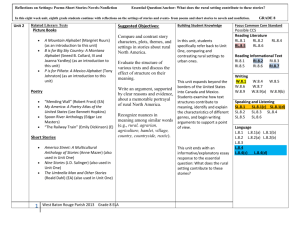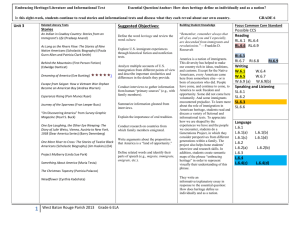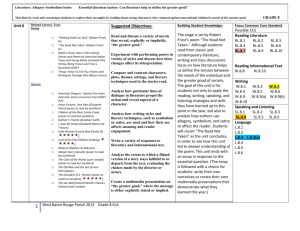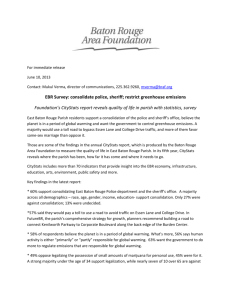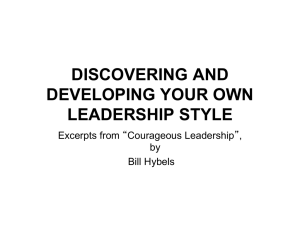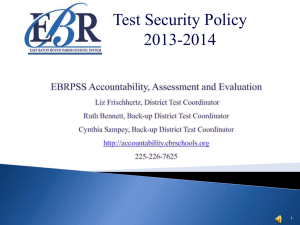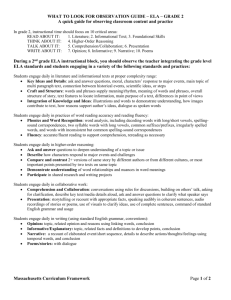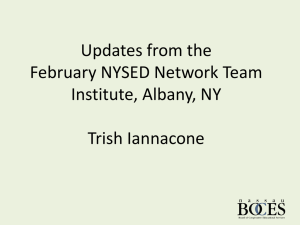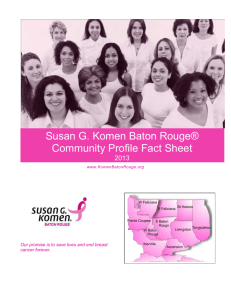CCSS Unit 4 Gr6 ELA DHenry
advertisement
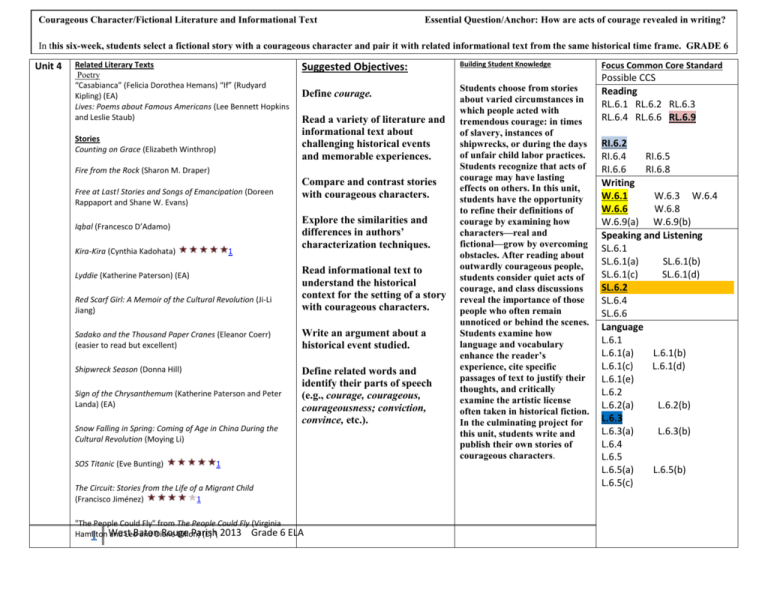
Courageous Character/Fictional Literature and Informational Text Essential Question/Anchor: How are acts of courage revealed in writing? In this six-week, students select a fictional story with a courageous character and pair it with related informational text from the same historical time frame. GRADE 6 Unit 4 Related Literary Texts Poetry “Casabianca” (Felicia Dorothea Hemans) “If” (Rudyard Kipling) (EA) Lives: Poems about Famous Americans (Lee Bennett Hopkins and Leslie Staub) Stories Counting on Grace (Elizabeth Winthrop) Suggested Objectives: Define courage. Read a variety of literature and informational text about challenging historical events and memorable experiences. Fire from the Rock (Sharon M. Draper) Free at Last! Stories and Songs of Emancipation (Doreen Rappaport and Shane W. Evans) Iqbal (Francesco D’Adamo) Kira-Kira (Cynthia Kadohata) 1 Compare and contrast stories with courageous characters. Explore the similarities and differences in authors’ characterization techniques. Red Scarf Girl: A Memoir of the Cultural Revolution (Ji-Li Jiang) Read informational text to understand the historical context for the setting of a story with courageous characters. Sadako and the Thousand Paper Cranes (Eleanor Coerr) (easier to read but excellent) Write an argument about a historical event studied. Shipwreck Season (Donna Hill) Define related words and identify their parts of speech (e.g., courage, courageous, courageousness; conviction, convince, etc.). Lyddie (Katherine Paterson) (EA) Sign of the Chrysanthemum (Katherine Paterson and Peter Landa) (EA) Snow Falling in Spring: Coming of Age in China During the Cultural Revolution (Moying Li) SOS Titanic (Eve Bunting) 1 The Circuit: Stories from the Life of a Migrant Child (Francisco Jiménez) 1 "The People Could Fly" from The People Could Fly (Virginia Rouge Parish Hamilton West and LeoBaton and Diane Dillon) (E) \ 2013 Grade 6 ELA 1 Building Student Knowledge Students choose from stories about varied circumstances in which people acted with tremendous courage: in times of slavery, instances of shipwrecks, or during the days of unfair child labor practices. Students recognize that acts of courage may have lasting effects on others. In this unit, students have the opportunity to refine their definitions of courage by examining how characters—real and fictional—grow by overcoming obstacles. After reading about outwardly courageous people, students consider quiet acts of courage, and class discussions reveal the importance of those people who often remain unnoticed or behind the scenes. Students examine how language and vocabulary enhance the reader’s experience, cite specific passages of text to justify their thoughts, and critically examine the artistic license often taken in historical fiction. In the culminating project for this unit, students write and publish their own stories of courageous characters. Focus Common Core Standard Possible CCS Reading RL.6.1 RL.6.2 RL.6.3 RL.6.4 RL.6.6 RL.6.9 RI.6.2 RI.6.4 RI.6.5 RI.6.6 RI.6.8 Writing W.6.1 W.6.3 W.6.4 W.6.6 W.6.8 W.6.9(a) W.6.9(b) Speaking and Listening SL.6.1 SL.6.1(a) SL.6.1(b) SL.6.1(c) SL.6.1(d) SL.6.2 SL.6.4 SL.6.6 Language L.6.1 L.6.1(a) L.6.1(b) L.6.1(c) L.6.1(d) L.6.1(e) L.6.2 L.6.2(a) L.6.2(b) L.6.3 L.6.3(a) L.6.3(b) L.6.4 L.6.5 L.6.5(a) L.6.5(b) L.6.5(c) The Power of Light: Eight Stories for Hanukkah (Isaac Bashevis Singer and Irene Lieblich) (EA) The Tale of the Mandarin Ducks (Katherine Paterson and Leo and Diane Dillon) (E) Timothy of the Cay (Theodore Taylor) Under the Blood-Red Sun (Graham Salisbury) Uprising: Three Young Women Caught in the Fire That Changed America (Margaret Peterson Haddix) War Comes to Willy Freeman (James and Christopher Collier) (easier to read but excellent) Informational Texts/Nonfiction 2 A Night to Remember: A Classic Account of the Final Hours of the Titanic (Walter Lord) (E) Exploring the Titanic: How the Greatest Ship Ever Lost—Was Found (Robert D. Ballard) Harriet Tubman: Conductor on the Underground Railroad (Ann Petry) (E) Kids at Work: Lewis Hine and the Crusade Against Child Labor (Russell Freedman and Lewis Hine) (EA) Kids On Strike! (Susan Campbell Bartoletti) Kids with Courage: True Stories About Young People Making a Difference (Barbara A. Lewis) Leon’s Story (Leon Walter Tillage and Susan L. Roth) Life in Ancient Japan (Peoples of the Ancient World) (Hazel Richardson) Many Thousand Gone: African Americans from Slavery to Freedom (Companion to The People Could Fly) (Virginia Hamilton and Leo and Diane Dillon) Narrative of the Life of Frederick Douglass, An American Slave, Written by Himself (Frederick Douglass) (E) Rebels Against Slavery: American Slave Revolts (Patricia C. and Fredrick L. McKissack) Samurai: Warlords of Japan (High Interest Books) (Arlan Dean) Shipwreck at the Bottom of the World: The Extraordinary True Story of Shackleton and the Endurance (Jennifer Armstrong) Up Before Daybreak: Cotton and People in America (Deborah Hopkinson) West Baton Rouge Parish 2013 Grade 6 ELA You Wouldn't Want to Sail on the Titanic! One Voyage You'd Rather Not Make (You Wouldn’t Want To…Series) (David Stewart, David Salariya and David Antram) Art, Music and Media Art o o o o o Music o o o Unit 3: Frederick Douglass Home (Washington, DC, ca. 1855) Iwo Jima Memorial (Rosslyn, Virginia, 1954) Lincoln Memorial (Washington, DC, 1912-1922) Vietnam War Memorial (Washington, DC, 1982) Washington Monument (Washington, DC, 1848-1888) Terminology: Antagonist Traditional, “Cotton Mill Girls” (as sung by Michèle Welborne) Traditional, “Nobody Knows the Trouble I’ve Seen” Traditional, possibly Wallis Willis, “Swing Low, Sweet Chariot” Character Development Protagonist Weeks 21-26 Unit 4 Fictional Literature and Informational Text “I CAN” Statements Standards for Unit 4 Reading Literature RL.6.1 Read closely to determine what the text says explicitly and to make logical inferences from it; cite specific textual evidence when writing or speaking to support conclusions drawn from the text. RL.6.2 Assess how point of view or purpose shapes the content and style of a text. RL.6.3 Analyze how and why individuals, events, and ideas develop and interact over the course of a text 3 West Baton Rouge Parish 2013 Grade 6 ELA I can analyze text to cite textual evidence which is explicitly stated. I can analyze text to cite textual evidence which is inferred. I can analyze supporting details used to determine theme or central idea. I can distinguish between textual facts and opinions. I can formulate a summary based on facts from the text I can describe how a plot unfolds in a series of episodes. I can explain how character(s) respond or change over the course of the story or drama. RL.6.4 Interpret words and phrases as they are used in a text, including determining technical, connotative, and figurative meanings, and analyze how specific word choices shape meaning or tone. I can determine the meaning of words and phrases as they are used in a text, including figurative and connotative meanings. I can analyze the impact of a specific word choice on meaning and tone. RL.6.6 Assess how point of view or purpose shapes the content and style of a text. FOCUS STANDARD RL.6.9 Analyze how two or more texts address similar themes or topics in order to build knowledge or to compare the approaches the authors take. Reading Informational Text FOCUS STANDARD RI.6.2 Determine central ideas or themes of a text and analyze their development; summarize the key supporting details and ideas. RI.6.4 Interpret words and phrases as they are used in a text, including determining technical, connotative, and figurative meanings, and analyze how specific word choices shape meaning or tone. RI.6.5 Analyze the structure of texts, including how specific sentences, paragraphs, and larger portions of the text (e.g., a section, chapter, scene, orstanza) relate to each other and the whole. I can compare and contrast point of view of the narrator to characters in a text. I can analyze how the author develops these different points of view. I can compare and contrast one author’s presentation of events with that of another (e.g., a memoir written by and a biography on the same person). I can determine a central idea of a text and how it is conveyed through particular details. I can provide a summary of the text distinct from personal opinions or judgments. I can determine the meaning of words and phrases as they are used in a text, including figurative and connotative meanings. I can analyze the impact of a specific word choice on meaning and tone. I can analyze how a particular sentence, chapter, scene, or stanza fits into the overall structure of a text and contributes to the development of the theme, setting, or plot. RI.6.6 Assess how point of view or purpose shapes the content and style of a I can explain how an author develops the point of view of the narrator or text. speaker in a text. RI.6.8 Delineate and evaluate the argument and specific claims in a text, I can trace and evaluate the argument and specific claims in a text. including the validity of the reasoning as well as the relevance and sufficiency of the evidence I can distinguishing claims that are supported by reasons and evidence from claims that are not Writing FOCUS STANDARD I can write arguments to support claims with clear reasons and relevant W.6.1 Write arguments to support claims in an analysis of substantive evidence. topics or texts, using valid reasoning and relevant and sufficient evidence. I can introduce claim(s) and organize the reasons and evidence clearly. 4 West Baton Rouge Parish 2013 Grade 6 ELA W.6.3 Write narratives to develop real or imagined experiences or events using effective technique, well-chosen details, and well-structured event sequences. I can write a narrative to develop real or imaginative experiences or events using effective techniques, relevant descriptive details, and well‐structured event sequences. W.6.4 Produce clear and coherent writing in which the development, organization, and style are appropriate to task, purpose, and audience. I can produce a writing piece that is clear and coherent with idea development, organization, and style appropriate to task, purpose, and audience. I can use technology, including the Internet, to produce and publish writing as well as to interact and collaborate with others. FOCUS STANDARD W.6.6 Use technology, including the Internet, to produce and publish writing and to interact and collaborate with others. W.6.8 Gather relevant information from multiple print and digital sources, assess the credibility and accuracy of each source, and integrate the information while avoiding plagiarism. I can demonstrate sufficient command of keyboarding skills to type a minimum of three pages in a single sitting. I can gather relevant information from multiple print and digital sources. I can assess the credibility of each source. I can quote or paraphrase the data and conclusions of others while avoiding plagiarism and providing basic bibliographic information for sources. W.6.9 Draw evidence from literary or informational texts to support analysis, reflection, and research. a. Apply grade 6 Reading standards to literature (e.g., “Compare and contrast texts in different forms or genres [e.g., stories and poems; historical novels and fantasy stories] in terms of their approaches to similar themes and topics”). b. Apply grade 6 Reading standards to literary nonfiction (e.g., “Trace and evaluate the argument and specific claims in a text, distinguishing claims that are supported by reasons and evidence from claims that are not”). Speaking and Listening SL.6.1 Prepare for and participate effectively in a range of conversations and collaborations with diverse partners, building on others‟ ideas and expressing their own clearly and persuasively. I can draw evidence from key ideas and details as support for research. I can analyze key ideas and details in a text as evidence for support understanding of text. I can reflect on key ideas and details in a text as evidence for support understanding of text. I can engage effectively in a range of collaborative discussions (one-on-one, in groups, and teacher-led) with diverse partners on grade 6 topics, texts, and issues, building on others‟ ideas and expressing their own clearly. Come to discussions prepared having read or studied required material; explicitly draw on that preparation by referring to evidence on the topic, text, or issue to probe and reflect on ideas under discussion. I can follow rules for collegial discussions, set specific goals and deadlines, 5 West Baton Rouge Parish 2013 Grade 6 ELA and define individual roles as needed. I can pose and respond to specific questions with elaboration and detail by making comments that contribute to the topic, text, or issue under discussion. I can review the key ideas expressed and demonstrate understanding of multiple perspectives through reflection and paraphrasing. FOCUS STANDARDS SL.6.2 Integrate and evaluate information presented in diverse media and formats, including visually, quantitatively, and orally. SL.6.4 Present information, findings, and supporting evidence such that listener scan follow the line of reasoning and the organization, development, and style are appropriate to task, purpose, and audience. SL.6.6 Adapt speech to a variety of contexts and communicative tasks, demonstrating command of formal English when indicated or appropriate. Language L.6.1 Demonstrate command of the conventions of standard English grammar and usage when writing or speaking. I can interpret information presented in diverse media and formats (e.g.,visually, quantitatively, orally) I can explain how it contributes to a topic, text, or issue under study. I can present claims and findings. I can sequence ideas logically and using pertinent descriptions, facts, and details to accentuate main ideas or themes. I can use appropriate eye contact, adequate volume, and clear pronunciation. I can adapt speech to a variety of contexts and tasks, demonstrating command of formal English when indicated or appropriate. I can demonstrate command of the conventions of standard English grammar and usage when writing or speaking. I can identify and use pronouns are in the proper case (subjective, objective, possessive). I can use intensive pronouns correctly (e.g., myself, ourselves). I can recognize and correct inappropriate shifts in pronoun number and person. I can recognize and correct vague pronouns (i.e., ones with unclear or ambiguous antecedents). 6 West Baton Rouge Parish 2013 Grade 6 ELA I can recognize variations from Standard English in their own and others' writing and speaking, and identify and use strategies to improve expression in conventional language.* L.6.2 Demonstrate command of the conventions of standard English capitalization, punctuation, and spelling when writing. I can demonstrate command of the conventions of standard English capitalization, punctuation, and spelling when writing. I can use punctuation (commas, parentheses, dashes) to set off nonrestrictive/parenthetical elements.* I can spell correctly. FOCUS STANDARD L.6.3 Apply knowledge of language to understand how language functions in different contexts, to make effective choices for meaning or style, and to comprehend more fully when reading or listening. I can use knowledge of language and its conventions when writing, speaking, reading, or listening. I can vary sentence patterns for meaning, reader/listener interest, and style. I can maintain consistency in style and tone. L.6.4 Determine or clarify the meaning of unknown and multiple-meaning words and phrases by using context clues, analyzing meaningful word parts, and consulting general and specialized reference materials, as appropriate. I can determine or clarify the meaning of unknown and multiple-meaning words and phrases based on grade 6 reading and content, choosing flexibly from a range of strategies. I can use context (e.g., the overall meaning of a sentence or paragraph; a word’s position or function in a sentence) as a clue to the meaning of a word or phrase. I can use common, grade-appropriate Greek or Latin affixes and roots as clues to the meaning of a word (e.g., audience, auditory, audible). I can consult reference materials (e.g., dictionaries, glossaries, thesauruses), both print and digital, to find the pronunciation of a word or determine or clarify its precise meaning or its part of speech. I can verify the preliminary determination of the meaning of a word or phrase (e.g., by checking the inferred meaning in context or in a 7 West Baton Rouge Parish 2013 Grade 6 ELA L.6.5 Demonstrate understanding of word relationships and nuances in word meanings. dictionary). I can demonstrate understanding of figurative language, word relationships, and nuances in word meanings. I can interpret figures of speech (e.g., personification) in context. I can use the relationship between particular words (e.g., cause/effect, part/whole, item/category) to better understand each of the words. I can distinguish among the connotations (associations) of words with similar denotations (definitions) (e.g., stingy, scrimping, economical, unwasteful, thrifty). 8 West Baton Rouge Parish 2013 Grade 6 ELA
